News and Highlights
This is a list of past iUTAH EPSCoR news from 2012 to 2018.
September 17, 2015
iUTAH Post-doctoral Spotlight: Dr. Erik Oerter, RFA1

Erik comes to iUTAH from the University of California - Berkeley, where he studied how carbon, oxygen, and uranium isotopes in soils respond to climate for his PhD research. Part of this research was centered on how water behaves in soils, and that is his main focus here in Utah. Erik is using isotope-enabled soil water hydrology to better understand water in soils along the Wasatch Front, and how soil water contributes to streamflow and atmospheric water vapor.
August 21, 2015
Taking a "snapshot" of the Logan River
iUTAH researchers and students conducted our second synoptic sampling event of the summer Aug. 17-19, this time focusing on the Logan River. Working under the direction of iUTAH environmental engineer Dr. Bethany Neilson and her doctoral student Michelle Barnes, scientists from Utah State University, Brigham Young University, and the University of Utah took a hydrometric “snapshot” of the river to learn more about how the river is connected to groundwater and the adjacent air and land surface.
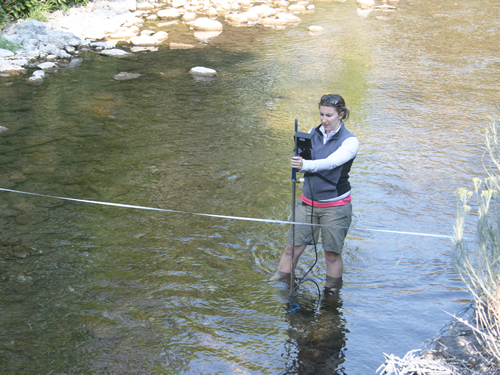
August 19, 2015
Explore Findings from the Utah Water Survey
Find out how the citizens of Utah feel about issues such as water shortages, water quality, air pollution, population growth and more by using our survey data viewer.
These data were collected by teams of students who randomly intercepted adults shopping at grocery stores across major population centers in Utah between September 2014 and June 2015. People were asked about their perceptions of water supply and water quality conditions in their community and levels of concern about 10 key issues. The survey also included information about their familiarity with spending on water, responsibility for watering lawns, water-based recreation activities, and basic demographic characteristics (including the zipcode of where they live).
For more information about methodology and copies of the full dataset, please contact Dr. Douglas Jackson-Smith.

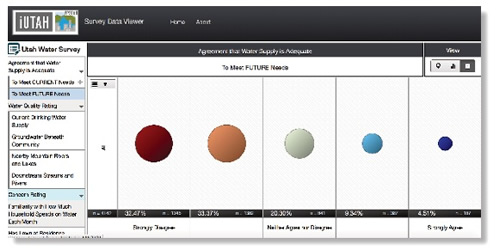
August 14, 2015
Utahns Voice their Ideas about Water
What’s the first thing that comes to mind when you think of water?
Scientists tend to think of issues as problems – water scarcity, declining water quality, and so on. But how do community members in Utah think about water? The Utah Water Voices Project, led by Dr. Courtney Flint with iFellows Zack Oldroyd and Andre Valle along with other USU students,* set out to open the water conversation with members of the public using social science research techniques.
The team selected six public spaces or parks along the Logan River to capture the iUTAH theme of a mountain to urban or valley gradient, and set out to conduct public intercept interviews at different times of day throughout the summer. Interview questions asked people about the values or benefits of water, as well as perceived threats or problems related to water in and beyond neighborhoods and communities. Flint’s students brought their interests in technology, setting up an interactive form on iPad tablets to guide paperless interviews and allow for quick collection of demographic data to help the survey team assess how well the their interviewees reflected the larger community. Interviews were audio recorded and lasted anywhere from 2 to 25 minutes (with an average of 7 minutes).
Interviewees spoke openly on a range of issues – from their thoughts on how important water is for their health and recreation to concerns about flooding, safety, pollution, and drought. Questions asked about interactions with different Utah water bodies and whether respondents would like to see their environmental condition changed – information that will be useful for the Utah Division of Water Quality as they try to incorporate local values and perspectives into their prioritization plans. iFellow Zack Oldroyd, who is studying Science Communication at Utah State, asked where people get their water information, revealing that a surprisingly high number of people don’t seek or receive any such information. iFellow Andre Valle, a Weber State Health Promotion major, sought to understand how well this research approach reaches a diverse cross-section of people and found that education, but not income or gender, is a very strong factor influencing whether people were willing to take part in interviews.
Over the course of the summer, Flint’s team of six completed 101 interviews in Logan and 33 in a 3-day effort in Salt Lake City. They created digital story videos by combining narration and photos with audio and transcript quotes from interviews. In the fall of 2015, they will work on creating an interactive web portal that will not only share the interviews with the wider public, but also invite more people from across Utah to share their water voices.
*USU Students Elizabeth Wynn, Charles Mascher, and Alex Brown contributed greatly to this research project by transcribing interviews, managing data, and helping to produce the multi-media videos to share water stories.

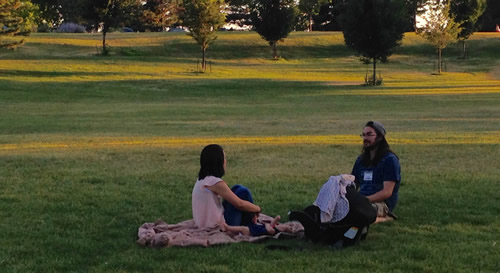
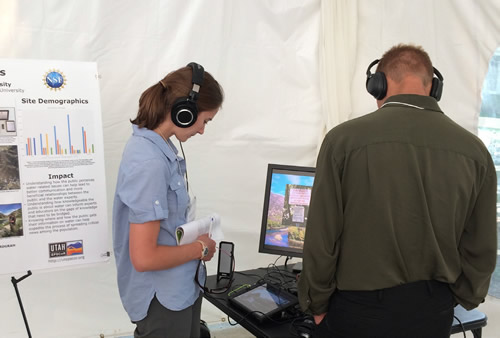
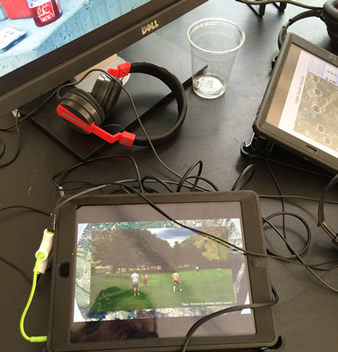
July 27, 2015
Insights into the urban water dynamics of Utah
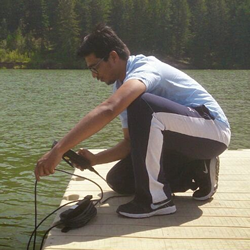 Public water supply systems are the life-blood of urban areas. How we use urban water systems affects more than human health and well-being. Our water use can alter a city’s energy balance, including how much solar energy is absorbed as heat or reflected back into space. It affects relationships among all living things within the city, and flows of water and natural chemicals through it. The severity of these effects, and the need to better understand connections between climate, water extraction, water use, and water use impacts, is strongest in dry climates and places undergoing substantial land-use change – for example, the rapidly urbanizing areas of Utah that are the focus of the iUTAH program.
Public water supply systems are the life-blood of urban areas. How we use urban water systems affects more than human health and well-being. Our water use can alter a city’s energy balance, including how much solar energy is absorbed as heat or reflected back into space. It affects relationships among all living things within the city, and flows of water and natural chemicals through it. The severity of these effects, and the need to better understand connections between climate, water extraction, water use, and water use impacts, is strongest in dry climates and places undergoing substantial land-use change – for example, the rapidly urbanizing areas of Utah that are the focus of the iUTAH program.
Studying the water’s “isotopic composition” – that is, the number and relative abundance of different isotope forms of common elements – can help us better understand these connections. University of Utah researcher Gabe Bowen and his PhD student, Yusuf Jameel, are studying how the isotopic composition of tap water in the Salt Lake Valley varies over space and time. With support from iUTAH, the group has gathered and analyzed stable water isotope data from a series of semi-annual hydrological surveys (spring and fall, 2013 and 2014) in urban tap water sampled across the Salt Lake Valley.
Their study has led to four major findings thus far: 1) Clear and substantial variation in tap water isotopic composition in space and time can be linked to different water sources and management practices within the urban area, 2) There is a strong correlation between the range of observed isotope values and the population of water districts, reflecting use of water from multiple local and non-local sources in districts with high water demand, 3) Water isotopes reflect significant and variable loss of water due to evaporation of surface water resources and 4) Overall, tap water contains lower concentrations of the heavy H and O isotopes than does rainfall within the basin, reflecting the connection between city water supplies and mountain water sources. The effect is increased as the climate grows drier and warmer.
Currently, Yusuf is writing a manuscript on his work and plans to submit it to a peer reviewed scientific journal. Gabe and Yusuf are also working with a major water supply company in the Salt Lake Valley to quantify the water loss during transmission and storage, the relative contribution from different sources of water, and transmission patterns of water in urban systems.
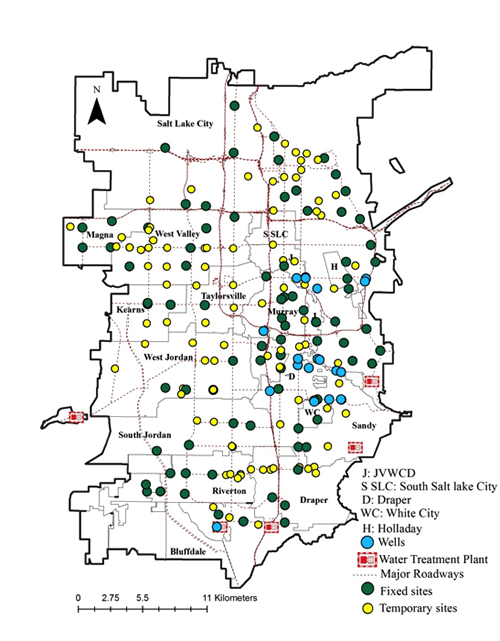
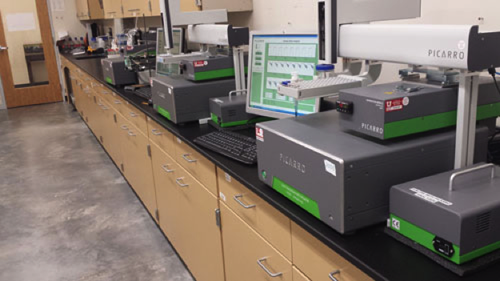
July 22, 2015
iUTAH Red Butte Creek Research
Nearly 50 researchers are converging on Red Butte Creek this week in a coordinated effort to understand the watershed like never before. The “synoptic sampling” event organized by iUTAH researcher and University of Utah hydrologist Paul Brooks brings together faculty and students from the University of Utah, Brigham Young University, Utah State University, Utah Valley University, Westminster College, and elsewhere to take a comprehensive “snapshot” of the water and surrounding land and air to better understand how to maintain a safe, stable water supply in the face of growing demand for water and a changing climate.

To learn more you can read, watch, and liste to what Salt Lake City-based news outlets have had to say about the event:


